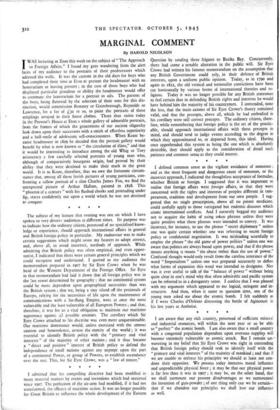MARGINAL COMMENT
By HAROLD NICOLSON
IWAS lecturing at Eton this week on the subject of " The Approach to Foreign Affairs." I found my gaze wandering from the alert faces of my audience to the portraits of their predecessors which adorned the walls. It was the custom in the old days for boys who had completed their time at Eton to present the headmaster with an honorarium or leaving present ; in the case of those boys who had displayed particular grandeur or ability the headmaster would offer to commute the honorarium for a portrait in oils. The parents of the boys, being flattered by the selection of their sons for this dis- tinction, would commission Romney or Gainsborough, Reynolds or Lawrence, for a fee of £30 or so, to paint the portraits of these striplings arrayed in their finest clothes. There thus exists today in the Provost's House at Eton a whole gallery of admirable portraits, from the frames of which the generations of our ancient oligarchy look down upon their successors with a smirk of effortless superiority and a half-smile of adolescent self-consciousness. When Keate be- came headmaster in 18o9 he decided that the portrait gallery would benefit by what is now known as " the circulation of elites," and that it would be interesting to introduce among the old Whig or Tory aristocracy a few carefully selected portraits of young men who, although of comparatively bourgeois origin, had proved by their ability that they were destined to make their mark in the great world. It is to Keate, therefore, that we owe the fortunate circum- stance that, among all those lavish pictures of young patricians, con- fronting a sallow portrait of a slim Charles James Fox, we find the unexpected picture of Arthur Hallam, painted in 1828. This " phoenix of a century " with his flushed cheeks and protruding under lip, stares confidently out upon a world which he was not destined to conquer.


























 Previous page
Previous page